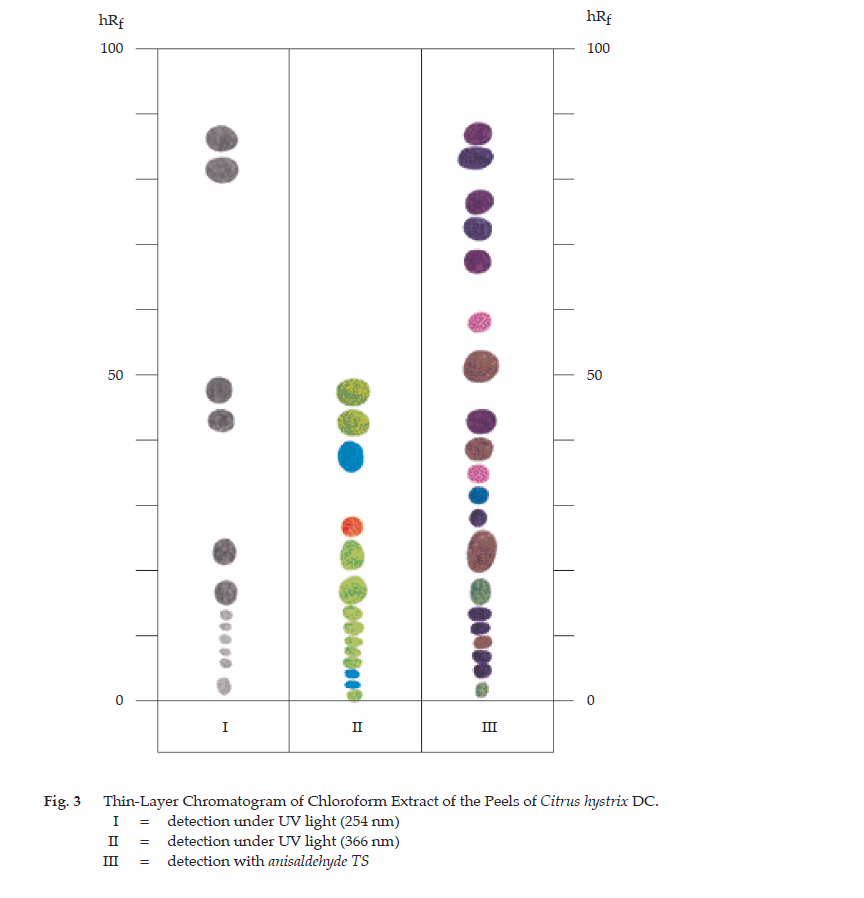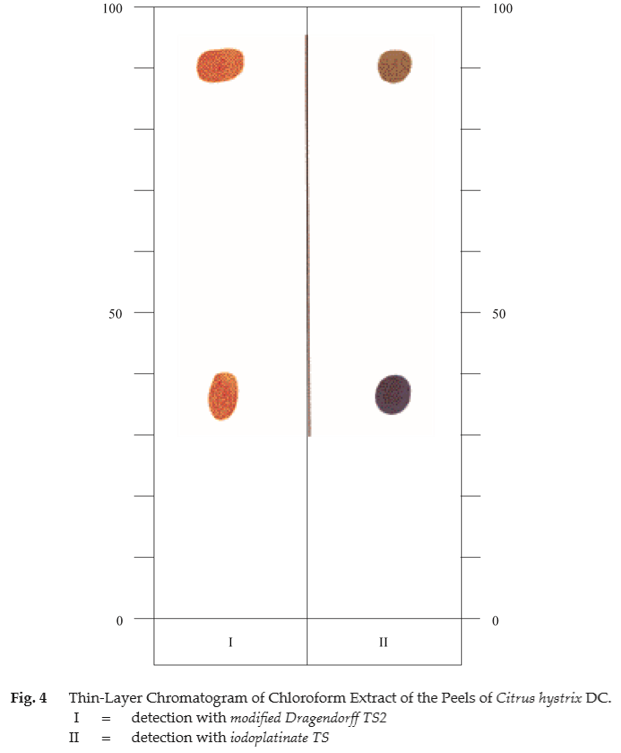ตำรามาตรฐานยาสมุนไพรไทย
Thai Herbal Pharmacopoeia
สำนักยาและวัตถุเสพติด กรมวิทยาศาสตร์การแพทย์ กระทรวงสาธารณสุข
Bureau of Drug and Narcotic, Department of Medical Sciences, Ministry of Public Health(Tinospora crispa (L.) Hook.f. & Thomson)
(Nelumbo nucifera Gaertn.)
(Centella asiatica (L.) Urb.)
(Centella Dry Extract)
(Centella Cream)
(Mesua ferrea L.)
(Piper sarmentosum Roxb.)
(Piper sarmentosum Roxb.)
(Pterocarpus santalinus L. f.)
(Santalum album L.)
(Senna tora (L.) Roxb.)
(Senna alata (L.) Roxb.)
(Senna Alata Tea)
(Piper retrofractum Vahl)
(Myristica fragrans Houtt)
(Andrographis paniculata (Burm. f.) Nees)
(Andrographis Capsules)
(Allium ascalonicum L.)
(Ocimum tenuiflorum L.)
(Curcuma longa L.)
(Turmeric Capsules)
(Turmeric Dry Extract)
(Turmeric Dry Extract Capsules)
(Arcangelisia flava (L.) Merr.)
(Curcuma sp.)
Harrisonia perforata (Blanco) Merr.
(Aristolochia pierrei Lecomte)
(Zingiber officinale Roscoe)
(Ginger Capsules)
(Ginger Tea)
(Cassia fistula L.)
(Nardostachys jatamansi (D. Don) DC.)
(Angelica sinensis (Oliv.) Diels)
Artemisia annua L.
(Ligusticum sinense Oliv. cv. Chuanxiong)
(Neopicrorhiza scrophulariiflora Pennell)
(Atractylodes lancea (Thunb.) DC.)
(Aucklandia lappa Decne)
(Terminalia chebula Retz.)
(Angelica dahurica (Hoffm.) Benth. & Hook. f. ex Franch. & Sav. var. dahurica)
(Kaempferia parviflora Wall. ex Baker)
(Hibiscus sabdariffa L.)
(Roselle Tea)
(Allium sativum L.)
(Zingiber zerumbet (L.) Sm.)
(Wurfbainia testacea (Ridl.) Škorničk.& A. D. Poulsen)
(Cannabis sativa L.)
(Myristica fragrans Houtt)
(Dracaena cochinchinensis (Lour.) S. C. Chen)
(Ficus racemosa L.)
(Hyptis suaveolens (L.) Poit.)
Clerodendrum indicum (L.) Kuntze
(Phyllanthus emblica L.)
(Citrus hystrix DC.)
(Citrus hystrix DC.)
(Areca catechu L.)
(Momordica charantia L.)
Moringa oleifera Lam.
(Aegle marmelos (L.) Corrêa)
(Solanum trilobatum L.)
(Morus alba L.)
Gynostemma pentaphyllum(Thunb.)
Makino
(Clinacanthus nutans (Burm. f.) Lindau)
(Cissus quadrangularis L.)
(Mimusops elengi L.)
(Zingiber montanum (J. König) Link. ex A. Dietr.)
(Piper betle L.)
(Capsicum annuum L.)
(Capsicum Oleoresin)
(Capsicum Gel)
(Piper nigrum L.)
(Piper nigrum L.)
(Eurycoma longifolia Jack)
(Thunbergia laurifolia Lindl.)
(Piper wallichii (Miq.) Hand.-Mazz.)
Senna garrettiana (Craib) H. S. Irwin & Barneby
(Terminalia bellirica (Gaertn.) Roxb.)
(Terminalia chebula Retz.)
(Caesalpinia bonduc (L.) H. Roxb.)
(Tarlmounia elliptica (DC.) H. Rob., S. C. Keeley, Skvaria & R. Chan)
(Hog Creeper Vine Dry Extract Capsiles)
(Hog Creeper Vine Dry Extract)
(Brachypterum scandens (Roxb.) Miq.)
(Lepidium sativum L.)
(Nigella sativa L.)
(Cuminum cyminum L.)
(Foeniculum vulgare Mill.)
(Plantago ovata Forssk.)
(Pimpinella anisum L.)
(Carum carvi L.)
(Anethum graveolens L.)
(Trachyspermum ammi (L.) Sprague)
Albizia procera (Roxb.) Benth.
(Acorus calamus L.)
(Tiliacora triandra (Colebr.) Diels)
Cyanthillium cinereum (L.) H. Rob.
(Orthosiphon aristatus (Blume) Miq.)
Murdannia loriformis (Hassk.) R. S. Rao & Kammathy
(Capparis micracantha DC.)
(Chrysopogon zizanioides (L.) Roberty)
(Cyperus rotundus L.)
(Cannabis sativa L.)
(Syzygium aromaticum (L.) Merr. & L. M. Perry)
(Boesenbergia rotunda (L.) Mansf.)
(Acanthus ebracteatus Vahl)
(Acanthus ilicifolius L.)
(Kaempferia galanga L.)
(Curcuma comosa Roxb.)
Betula alnoides Buch.-Ham. ex D. Don
Cannabis sativa L.
Carthamus tinctorius L
Mitragyna speciosa (Korth.) Havil
Mallotus repandus (Rottler) Müll. Arg
Azadirachta indica A. Juss. var. siamensis Valeton
Azadirachta indica A. Juss. var. siamensis Valeton
Punica granatum L.
Rhinacanthus nasutus (L.) Kurz
Baliospermum solanifolium (Burm.) Suresh
Curcuma aeruginosa Roxb
Boesenbergia kingii Mood & L. M. Prince
Senegalia rugata (Lam.) Britton & Rose
Acacia concinna (Willd.) DC.
Senegalia rugata (Lam.) Britton & Rose
Acacia concinna (Willd.) DC.
Senna alexandriana Mill. var. alexandriana
Cassia acutifolia Delile, Cassia angustifolia Vahl
Butea superba Roxb. ex Willd.
[Plaso superba (Roxb. ex Willd.) Kuntze, Rudolphia superba (Roxb. ex Willd.) Poir.
Pueraria candollei Graham
ex Benth. var. mirifica (Airy Shaw & Suvat.) Niyomdham
Streblus asper Lour.
Suregada multiflora (A. Juss.) Baill. (Gelonium
multiflorum A. Juss.
Citrus Hystrix Peel is the dried exocarp and mesocarp of green mature fruit of Citrus hystrix DC. (C. papeda Miq., C. tuberoides J. W. Benn.) (Family Rutaceae), Herbarium Specimen Number: DMSC 1459.
Constituents Citrus Hystrix Peel contains volatile oil, of which β-pinene, limonene, β-phellandrene, and citronellal are its major components. It also contains linalool, borneol, camphor, sabinene, germacrene D, aviprin, umbelliferone, β-sitosterol, etc.
Description of the plant See under Citrus Hystrix Leaf, See also Figs. 1a, 1b.
Description Odour, characteristic, aromatic; taste, bitter.
Macroscopical (Fig. 1) Citrus Hystrix Peel occurs as strips of dried fruit rind; outer surface dark green to brown, rough with pits of oil glands; inner surface exhibiting whitish spongy part.
Microscopical (Figs. 2a, 2b) Transverse section of the exocarp and mesocarp shows exocarp, a layer of rectangular cells covered by thick cuticle. Mesocarp, the outer part composed of several layers of thick-walled parenchyma containing chromoplastids; the inner part composed of thick-walled spongy parenchyma; vascular bundles, scattered; vessels, lignified reticulate and spiral. Prismatic crystals of calcium oxalate and schizolysigenous oil cavities containing oil droplets are also found.
Citrus Hystrix Peel in powder possesses the diagnostic microscopical characters of the unground drug.
Additional information Citrus Hystrix Peel in this monograph refers to exocarp with attached unremovable mesocarp.
Packaing and storage Citrus Hystrix Peel shall be kept in well-closed containers, preferably of metal or glass, protected from light and stored in a cool and dry place. It should be used within 1 year and air-dried every 2 to 3 months.
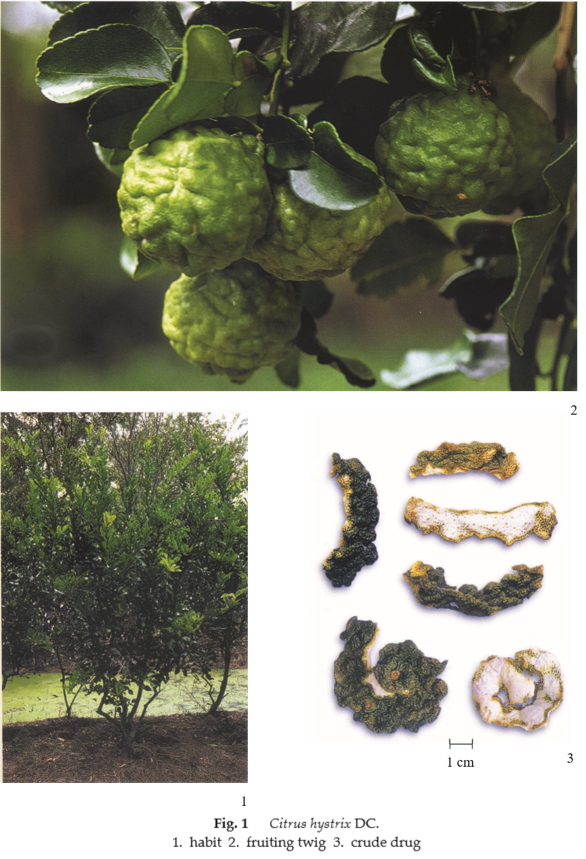
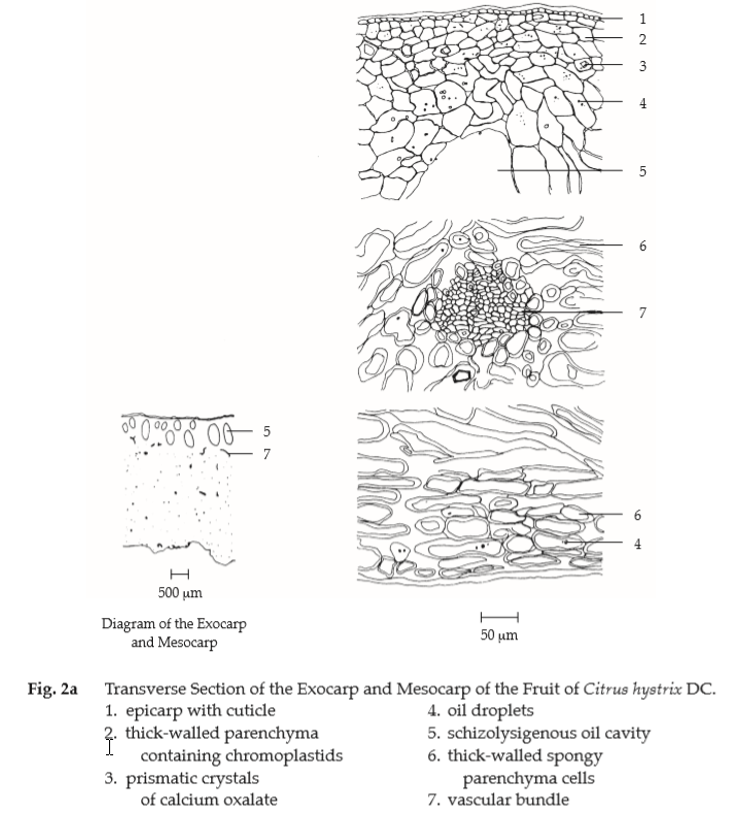
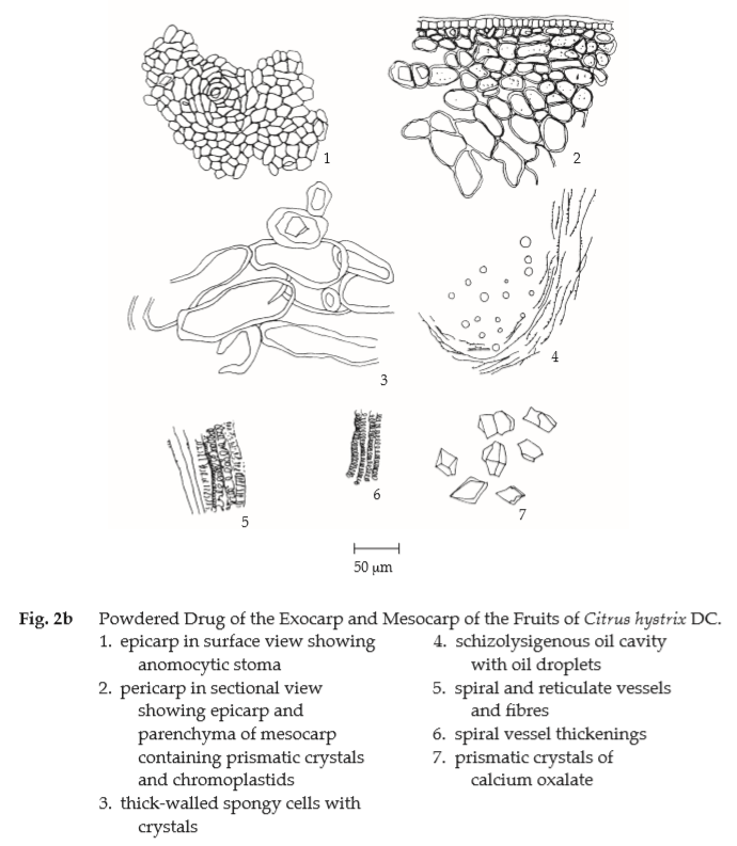
Identification
A. Reflux 1 g of the sample, in powder, with 30 mL of ethanol for 15 minutes, and filter (solution 1). To 2 mL of solution 1, add a few drops of ammonium molybdate TS: a bright yellow precipitate is produced.
B. To 2 mL of solution 1, add a few drops of a freshly prepared 1 per cent w/v solution of iron(III) chloride: a deep greenish brown colour is produced.
C. To 2 mL of solution 1, add a few drops of ninhydrin TS and warm on a water-bath for a few minutes: a reddish purple colour is produced.
D. Moisten 1 g of the sample, in powder, with 0.5 mL of strong ammonia solution, add 5 mL of chloroform, occasionally shaking for 10 minutes, and filter. Evaporate the filtrate until dryness and dissolve the residue in 1 mL of ethanol, and add a few drops of modified Dragendorff TS2: an orange precipitate is produced.
E. Extract 1 g of the sample, in powder, with 10 mL of chloroform, shake occasionally for 20 minutes, and filter. Evaporate 2 mL of the filtrate to dryness, dissolve the residue in 2 mL of acetic anhydride, and add slowly 1 mL of sulfuric acid to make two layers: a brown colour forms at the zone of contact and the upper layer is green.
F. Carry out the test as described in the “Thin-Layer Chromatography” (Appendix 3.1), using silica gel GF254 as the coating substance and chloroform as the mobile phase. Apply to the plate, 5 μL of the test solution prepared by moistening 1 g of the sample, in powder, with 1 mL of strong ammonia solution for a while, extracting with 10 mL of chloroform by occasionally shaking for 15 minutes, filtering, and concentrating the filtrate to 1 mL. After removal of the plate, allow it to dry in air, and examine under ultraviolet light (254 nm), marking the quenching spots. Examine the plate under ultraviolet light (366 nm) (Table 1); see also Fig. 3. Spray the plate with anisaldehyde TS and heat at 105° for 5 minutes. Several spots of different colours are observed (Table 1); see also Fig. 3.
Repeat the same procedure on other two plates but use a mixture of 20 volumes of chloroform and 1 volume of methanol as the mobile phase and allow the solvent front to ascend 12 cm above the line of application. After removal of the plates, allow them to dry in air, and spray one plate with modified Dragendorff TS2: two orange spots are observed. Spray another plate with iodoplatinate TS: one dark blue spot and one brown spot are observed (Table 1); see also Fig. 4.
Table 1 hRf Values of Components in Chloroform Extract of the Peels of Citrus hystrix DC
a. Mobile phase: chloroform
| Spot | hRf Value | Detection | ||
| UV 254 | UV 366 | Anisaldehyde TS | ||
| 1 2 3 4 5 6 7 8 9 10 11 12 13 14 15 16 17 18 19 20 21 22 23 24 25 26 27 |
0-2 1-4 2-3 4-5 5-7 7-9 8-11 10-13 12-15 15-20 20-26 25-28 29-31 33-34 36-38 36-39 39-41 41-48 46-50 51-54 58-61 68-70 73-76 77-80 81-84 84-86 86-90 |
- quenching - - quenching quenching quenching quenching quenching quenching quenching - - - - - - quenching quenching - - - - - quenching - quenching |
light green - blue blue light green light green light green light green light green light green light green red - - - blue - green green - - - - - - - - |
- green - - bluish violet bluish violet brown bluish violet bluish violet green brown - bluish violet blue pink - brown violet - brown pink violet bluish violet violet - bluish violet violet |
b. Mobile phase: 20 volumes of chloroform and 1 volume of methanol
| Spot | hRf Value | Detection | |
| Modified Dragendorff TS2 | Iodoplatinate TS | ||
| 1 2 |
33-40 87-92 |
orange orange |
dark blue brown |
Water Not more than 12.0 per cent v/w (Azeotropic Distillation Method, Appendix 4.12).
Foreign matter Not more than 2.0 per cent w/w (Appendix 7.2).
Acid-insoluble ash Not more than 1.0 per cent w/w (Appendix 7.6).
Total ash Not more than 9.0 per cent w/w (Appendix 7.7).
Ethanol-soluble extractive Not less than 11.0 per cent w/w (Appendix 7.12).
Water-soluble extractive Not less than 23.0 per cent w/w (Appendix 7.12).
Chloroform-soluble extractive Not less than 8.0 per cent w/w (Appendix 7.12H).
Volatile oil Not less than 2.0 per cent v/w (Appendix 7.3H). Use 25 g, in coarse powder, freshly prepared and accurately weighed. Use 250 mL of water as the distillation liquid and a 500-mL round-bottomed flask. Distil at a rate of 2 to 3 mL per minute for 5 hours. Use 2.0 ml of xylene in the graduated tube.
